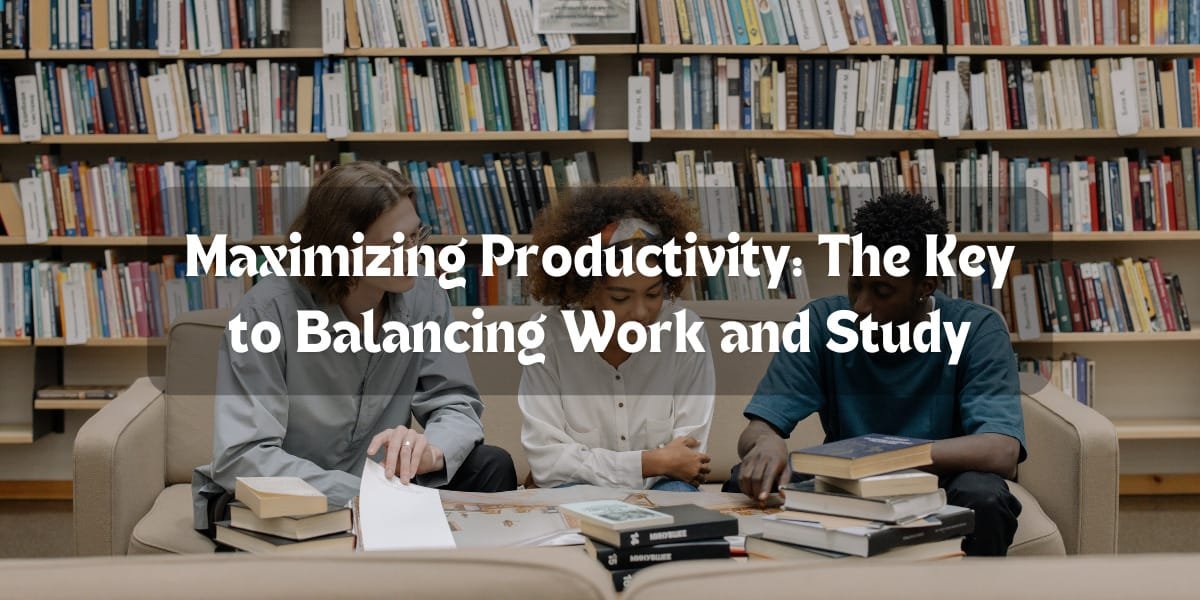

Introduction
Students often find themselves balancing work and study. Whether you’re working part-time to support your education or handling a full-time job while pursuing your degree, finding ways to be productive is essential. Maximizing productivity isn’t just about working harder—it’s about working smarter. By learning effective time management, prioritization, and maintaining a work-life balance, students can excel both academically and professionally. This blog will explore practical strategies for maximizing productivity while balancing work and study, ensuring that you can make the most of your time without feeling overwhelmed.
1. Prioritize Tasks with the Eisenhower Matrix
When juggling multiple responsibilities, it’s important to know which tasks require immediate attention and which can be delayed. The Eisenhower Matrix is a powerful tool that helps you prioritize tasks based on urgency and importance. This tool divides tasks into four categories:
- Urgent and Important: These tasks need immediate attention (e.g., deadlines, urgent assignments).
- Important but Not Urgent: These tasks contribute to long-term goals and should be scheduled (e.g., long-term projects, personal development).
- Urgent but Not Important: Tasks that can be delegated or minimized (e.g., routine meetings, some emails).
- Not Urgent and Not Important: Tasks that are distractions and should be eliminated.
By focusing on urgent and important tasks, you can effectively manage your workload and ensure that both work and study commitments are met.
2. Use Time Blocking for Effective Scheduling
Time blocking is a time management technique where you divide your day into specific blocks of time dedicated to particular tasks. This method ensures that you have designated time for both work and study, and helps you stay organized throughout the day.
For example, you could block out:
- 9 AM to 12 PM for study time
- 12 PM to 1 PM for lunch and a break
- 1 PM to 5 PM for work-related tasks
- 5 PM to 6 PM for reviewing your study materials or completing smaller tasks
Time blocking reduces the chance of distractions and helps you allocate focused time to your tasks. This method works especially well for students who need to balance a job with their studies.
3. Leverage Productivity Apps and Tools
There are a variety of productivity apps and tools designed to help you stay organized and on track with your tasks. Some popular options include:
- Trello: An easy-to-use project management tool that helps you visually organize tasks and deadlines.
- Todoist: A task manager app that allows you to create to-do lists, set deadlines, and track progress.
- Google Calendar: For scheduling study sessions, work shifts, and personal activities.
Using these tools helps you track both work and study commitments, set reminders for deadlines, and ensure that nothing is overlooked.
4. Focus on Deep Work and Minimize Multitasking
While multitasking may seem like a time-saver, it can actually reduce your productivity. Studies have shown that multitasking leads to decreased focus and lower quality of work. Instead, practice deep work by dedicating uninterrupted blocks of time to one task at a time. For example, when studying, turn off notifications, avoid checking emails, and focus solely on the task at hand. Similarly, when working, dedicate your time to completing work tasks without switching between tasks or checking social media. The more you can immerse yourself in a single task, the more productive and efficient you will be.
5. Use the Pomodoro Technique to Avoid Burnout
The Pomodoro Technique is a time management method that helps increase productivity by working in focused intervals. Typically, you work for 25 minutes and then take a 5-minute break. After completing four Pomodoros, you take a longer break (15-30 minutes). This technique helps maintain focus and prevents burnout by ensuring you take regular breaks. For students balancing work and study, the Pomodoro Technique is a great way to maintain energy and productivity without feeling drained. You can apply the technique both to work-related tasks and study sessions, ensuring you stay fresh and focused throughout the day.
6. Set Clear, Achievable Goals
Setting clear, measurable goals is key to staying productive. Whether you’re working on an assignment or a work project, breaking tasks down into smaller, achievable steps makes them more manageable and less overwhelming. For example, rather than simply saying, “I need to study for the exam,” break it down into:
- Review Chapter 1
- Complete practice problems
- Review lecture notes
Similarly, at work, set specific goals for each day or week, such as responding to emails, completing reports, or attending meetings. By breaking larger tasks into smaller, more manageable goals, you create a sense of accomplishment with every step you complete.
7. Practice Self-Care to Maintain Productivity
Balancing work and study can be physically and mentally exhausting, so it’s important to take care of yourself. Ensure that you get enough sleep, exercise, and eat nutritious meals to maintain energy levels. Additionally, make time for activities that help you unwind and recharge, such as reading, exercising, or spending time with loved ones. Self-care is essential for maintaining long-term productivity and avoiding burnout. By taking care of your body and mind, you’ll have more focus, energy, and motivation to succeed in both work and study.
8. Seek Support When Needed
If you’re struggling to balance work and study, don’t hesitate to seek support. Whether it’s from a mentor, supervisor, or academic advisor, asking for guidance can help you manage your time more effectively and reduce stress. If you’re feeling overwhelmed, talk to your employer or professor about adjusting your schedule to accommodate your needs.
You don’t have to do it all on your own—reaching out for support can make all the difference in maintaining a healthy work-life-study balance.
Conclusion
Maximizing productivity while balancing work and study requires careful planning, effective time management, and a commitment to focus and self-care. By prioritizing tasks, using time-blocking, leveraging productivity tools, and practicing techniques like the Pomodoro Method, you can stay on top of both work and academic responsibilities. Setting clear goals and practicing deep work can help you achieve more without feeling overwhelmed. If you want to take your productivity to the next level and learn more about managing work-life balance, check out the Productivity and Time Management course at CoursePlus. This course provides valuable insights and strategies to help you achieve maximum productivity in both your work and studies.
Frequently asked Questions
How can I balance work and study effectively?
Prioritize tasks, use time-blocking, set achievable goals, and focus on deep work without multitasking. Regular breaks and self-care also help maintain productivity.
What is the Pomodoro Technique?
The Pomodoro Technique is a time management method where you work for 25 minutes, followed by a 5-minute break. After four sessions, take a longer break to recharge.
Can I really boost my productivity with apps?
Yes, apps like Trello, Todoist, and Google Calendar help you organize tasks, set reminders, and track your progress, making it easier to manage work and study.
How can I prevent burnout while managing work and study?
Regular breaks, time for self-care, and maintaining a healthy work-life balance are key to preventing burnout.
Courses Related To This Blog
Discover a range of carefully selected online courses crafted to enhance your skills across multiple topics. Engage with affordable, top-quality courses designed to provide in-depth learning and address your unique educational needs effectively.

Dealing With Difficult People In Life & Work - Powerful!

How To Be Successful in Network Marketing
Join the Community & Get Updates🔥
Related Post
Explore our latest expert insights, practical guides, and in-depth resources on trending topics designed to answer your questions, solve your challenges, and help you stay ahead with up-to-date trends and strategies.











